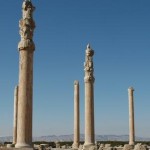- Latest Archaeology Updates
- Importance and applicability
- Famous Archaeologists
- Museums Collections
- Site Map
- World Heritage Sites
- World History Monuments
- Archaeological Organizations
- World Atlas of Archaeology
- Forensic Investigation and Geophysics
- Contact Us
- Movies based on Archaeology
- Frequently Asked Questions
- Archaeological discoveries
- Tell a Friend
- Archaeological Abbreviations
- Gallery Collections
- Famous-Museums site map
- Famous-archaeologists site map
- Archaeological Monuments site map
The Apadana is the name of the great audience hall at Persepolis. It belongs to the oldest building phase of the city,it built to during the first half of the 5th century BC as the part of the original design by Darius the Great, its construction completed by Xerxes I.
The Apadana covered an area of 112,000 square meters, its roof supported by 72 columns, each standing 20m tall 1.5 metres or 4.9 feet higher than the columns at the Temple of Artemis at Ephesus.
The entire hall was destroyed in 331 BC by the army of Alexander the Great, leaving only a single column standing. The stone of the columns was used as building material for nearby settlements, but after reconstruction work in the 20th century, 14 are again erect.Access to the hall is given by two monumental stairways, on the north and on the east.
These are decorated by reliefs, showing delegates of the 23 subject nations of the Persian Empire paying tribute to Darius I, who is represented seated centrally.
The various delegates are shown in great detail, giving insight into the costume and equipment of the various peoples of Persia in the 5th century BC. There are inscriptions in Old Persian and Elamite.

